-It is the best way to improve your relationship with drawing
-It’s a reflection of the real world through your eyes
-It forces you to look at what is there
-And to look at your own work
-The real world is interesting, because we all share it.
-When we observe the real world, we see from different viewpoints.
-It informs your understanding through experience
Some artist who use reference to influence their illustrations:
- Oliver Kugler
- Wesley Wilis
- David Sparshott
- Holly Wales
- Mr Bingo
Seeing- Eyes
Looking, selecting, viewpoints, context.
Visualising- Brain
Perception, translation, memory, imagination
Expressing- Hand
Representation, interpretation, communication, tone of voice, visual thinking
It is important to remember not to just draw the photograph; but to extract certain key elements from it in which you wish to use in your own work. It is an exercise in cognitive processing where you are interpreting and translating visual information, rather than creating a facsimile of the original. My reference material informed me of the basic visual information that communicated its subject. But it was my task as an illustrator to imbue more meaning through; the process by which I translate, interpret and play with the reference material; the media I chose to work in and how its unique aesthetic created its own tone of voice.
It is a good idea to begin with an idea or a concept and to think about the relevant signs and symbols. Drawing the same thing multiple times means a modulating process of reflection and decision making begins, it also allows for play and risk taking.
Using photographic reference...
The photograph is the basic information; the illustration is able to imbue more meaning through process and media. It looks like its subject but you can tell it's handmade by a skilled craftsman. Reference is used as a foundation to inform your artwork.
In order to go through the modulating process of reflection and decision making I have chosen 4 images, of a face, a figure, an organic object and a man made one, which I will then draw and re-draw over and over in my sketchbook. I will do this a minimum of 3 times to see how far I can go with my work and experiment with what works well.
These are my four images:
Below is some of my sketchbook development:
The Face
Working over and over again on the same image really helped me to see the essence of the woman rather than all the specific photographic details; this allowed me to play more with the process of creating her and the way I used colour and line, whilst still retaining an essence of her and recognizable link to the original photograph.
Pomegranate - Organic Object

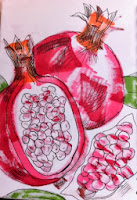
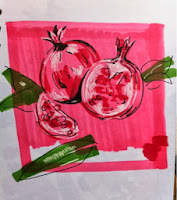
It was useful to draw this multiple times but using similar media and it helped me to see how differently something can be portrayed when it is just given a different tone of voice with block colours or with different thickness. I think the layering of pro markers worked well and I like the different shades and tones of colour this overlapping created. I think I could improve it by doing much more drawings of this same object and using different processes and techniques to see how large the range of outcomes could be from this one reference photograph.
Figure - Acrobat
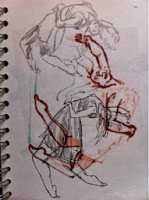
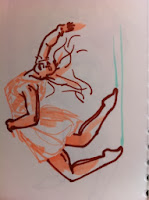
I dont think that these drawings were very successful as I dont think the media used or my line work conveys a sense of delicate and grace, or a free falling motion which is essential with what the image represents; dancers/acrobats. To improve these pieces I would use a thinner line and only use thick line in specific parts to show a line of movement or shadow. I think the top two are slightly more successful as I have explored shape and tone more which helps to convey a dynamic movement. However altogether this work could definitely be pushed more and if I had time I would definitely aim to explore conveying gesture and lightness more.
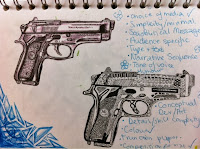
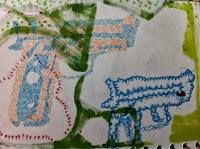





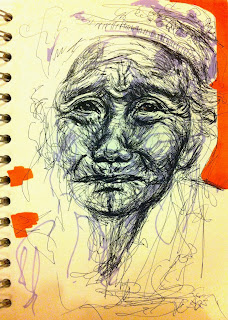





No comments:
Post a Comment